1
IT’S A SMALL-PLANT WORLD
What Are Compact Plants and Where to Find Them
Before introducing you to some of the best small-plant varieties for your landscape and discussing how to plant and care for them, it’s important to understand what makes a particular plant fit into the category of “compact.” What traits must it have to be considered small when compared to its relatives? And where do these plants come from in the first place?

WHAT EXACTLY IS A COMPACT PLANT?
As with people, plants come in a wide array of shapes and sizes. While some landscapes are large enough to handle a tree that grows 60 feet tall or a shrub that spreads 12 feet wide, lots of backyards don’t have enough space for such a substantial specimen. Not to mention the fact that many homeowners aren’t interested or able to be constantly pruning their plants to make them fit into a smaller yard. Thankfully, the nursery industry has taken notice of all of this, and it continues to develop and select plants with a restricted size for these smaller yards and gardens (more on this process in a bit).
Exactly which plants can be called compact is certainly debatable, but basically, when a particular plant variety exhibits a substantially reduced size when compared to other normal plants of the same species, that particular variety can be considered compact (sometimes also called dwarf). This size reduction can be exhibited in either the plant’s height or width—or, often, both. While the limited stature of these plants doesn’t necessarily make them miniatures (which is a whole other category of plants), it does indicate that the plants have a growth habit that’s smaller than normal for their species. In some cases, the speed of growth is limited, too.
There are hundreds of compact tree, shrub, and perennial varieties, many of which are featured throughout this book. Let’s take a closer look at each of these three groups separately and determine which traits they might have that make them “compact.”
Trees
NARROW GROWTH: When a tree is thinner than other trees within that same species, its slender form makes that variety fit under the umbrella of compact plants. Narrow trees that have a single trunk are called columnar trees. They may have upright branches or drooping pendulous ones, but their branches are always shorter and held close to the trunk. Fastigiate trees, on the other hand, are another group of tall, narrow trees; but these trees have multiple trunks or longer branches that reach straight up to the sky to create the narrow form. Both, though, are considered compact plants, even though some varieties of columnar and fastigiate trees can grow 60 feet tall or more. There are plenty of both types of these trees, however, that aren’t nearly as tall.
In chapters 4 and 5, I detail several varieties of these trees that are beautiful landscape plants, but a great example is the Apollo® Sugar Maple (Acer saccharum ‘Barrett Cole’). While standard sugar maples have a massive canopy spread that can quickly overtake even a modestly large backyard, Apollo® maxes out at just 8 to 10 feet wide, about a quarter of the size of a typical sugar maple. (You’ll find more about this variety in chapter 5.) Columnar and fastigiate trees are excellent for tight quarters, between homes, along streets, and next to patios—anywhere where wide branches wouldn’t be suitable.
SHORT STATURE: Trees can also be considered compact if their mature height is substantially shorter than others within their species. More often than not, this reduced height is coupled with a reduced spread as well, making these trees choice selections for postage stamp–sized yards or petite planting beds. Typically, compact trees in this category grow to less than half of the height of their relatives. A good example is the Sargent Tina Crabapple. This compact variety of the standard crabapple has beautiful blooms and is incredibly hardy, and it tops out at just 5 feet tall and 6 feet wide (see chapter 5 for more on the Sargent Tina Crabapple).

Slender trees, such as this ‘Wissel’s Saguaro’ false cypress, also fall under the umbrella of compact plants. While they’re tall, they don’t take up much room in the landscape.
Shrubs
When it comes to shrubs, the compact trait is most often shown in both the height and width of the mature plant. This means these shrubs keep their small stature without a lot of pruning or fuss. There are two basic groups of compact shrubs to be on the lookout for.
DECIDUOUS FLOWERING SHRUBS: These compact shrubs may have a reduced size, but they almost always produce full-sized blooms. Though they lose their leaves in the winter, shrubs in this group are real knockouts in the landscape. They have all the bloom power of their standard-sized cousins but in an itty-bitty package.
EVERGREEN SHRUBS: Though there are plenty of deciduous flowering shrubs for homeowners to include in their gardens, there are scores of compact evergreen shrubs, too. While some are needled evergreens, others are broad-leaved evergreens that may or may not produce showy blooms (think rhododendrons, azaleas, and laurels). But regardless of whether they’re needled or broad-leaved, evergreen varieties are terrific for foundation plantings, shrub islands, mixed borders, and even low hedgerows where the homeowner wants something “green” all year round.
You’ll find specifics on a wide selection of both deciduous and evergreen compact shrub varieties in chapters 4 and 5.

Compact shrubs that produce edible berries, such as this blueberry, keep their small stature and require little to no pruning.
Perennials
Compact perennials are the ideal fit for the front of foundation plantings, along sidewalks, next to patios and decks, in flower beds and borders, around mailboxes, and even in containers. The blooms of these plants are standard size for their species; it’s just the plant’s foliage height that’s smaller. Overall, dwarf perennials are lower growing, reaching a far shorter height than normal varieties of the same species. However, with a few exceptions, most spread just as wide as their full-sized counterparts, though they may take their time getting there.
Perennials are herbaceous plants that do not produce woody growth and return to the garden year after year, springing out of the ground when spring arrives as long as they’re planted in a region where they’ll survive the winter. Like trees and shrubs, perennials are classified in part by the hardiness zones in which they will survive.
In each of the plant profiles in subsequent chapters of this book, you’ll find I’ve noted the lowest winter temperature down to which each plant variety will survive without damage. This can help you determine which varieties of compact trees, shrubs, and perennials will grow in your garden.

Compact perennials can be used in flower beds and borders, at the front of homes, along sidewalks, and in many other areas. Here, they add color to a shady container in the corner of a small patio.
WHERE DO SMALL-STATURED PLANTS COME FROM?
Now that you know what traits make a plant compact, it’s time to discover where these plants come from. Despite what certain scare-tactic “news” articles may lead you to believe, the compact plants available to homeowners are not the result of some funky genetic-engineering technique. Yes, there are some dwarf farm crops that were created through genetic engineering, but as of this writing, there are no genetically engineered ornamental plants on the market. Instead, compact plants are selected or developed in one of three different ways.
First, compact plants can be selectively bred through classic plant-breeding methods where the breeder selects for the desired trait of a reduced mature plant size. Breeders look at a group of plants and select the most compact ones of the bunch; then they cross those plants with other shorter-statured selections. Eventually, through numerous judicious crosses over several generations, the dwarfing trait becomes more pronounced and stable. This method has been used by farmers and plant breeders since the dawn of agriculture to breed for any number of different desired traits, including things like bloom size, color, or time; improved hardiness or yields; disease resistance; or any other positive attributes that may be deemed desirable. This is a common method for creating compact vegetables, annuals, and perennial plant varieties. It’s less common, however, with trees and shrubs because it requires a far longer span of time for these types of plants to reach maturity.
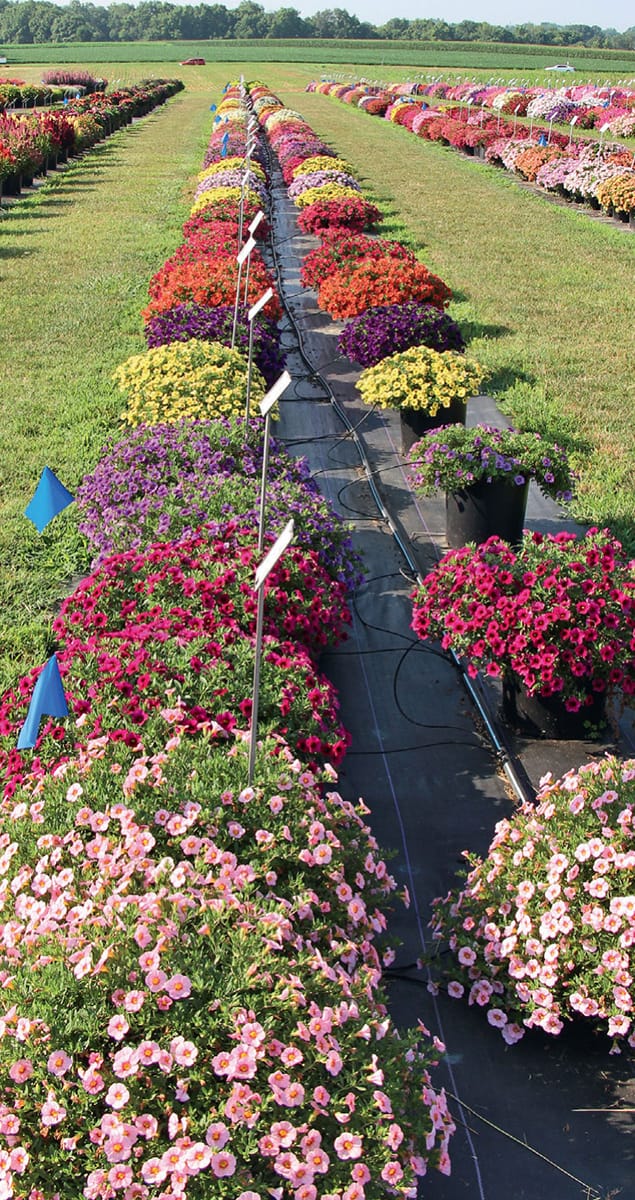
Trial gardens, like this one, grow and test many different varieties, carefully selecting only the best ones to bring to market.
Next, compact plants can be chosen from natural genetic variants found in a population of the plants. Genetic mutations occur frequently in the plant world, especially when growing from seed; and often, when examining a large group of seedlings, one can see a few natural genetic variations within the group. Whether it’s a random leaf variegation, a different flower color, or a change in plant stature or structure, genetic mutations happen often. Horticulture professionals, growers, and plant breeders are always on the prowl for natural variants that show desired traits. So, for example, if one seedling in a group of 100 grew to half the height of the others, it may be selected and grown to maturity to see if that dwarfing trait is also exhibited in the full-grown plant. If it is, the breeder may then decide to propagate the plant vegetatively to ensure the trait is present in future generations (more on this in a moment).
Natural genetic variants are sometimes found in nature, as well. Many of the compact trees and shrubs featured in this book were originally discovered as a single random specimen at a botanic garden, a breeding facility, a nursery, a private garden, or even in the wild. In most of these cases, the plants are then propagated vegetatively. Since these types of compact plants seldom grow true from seed (meaning plants grown from seeds harvested from these plants will not carry the same dwarfing trait), they are instead grown via leaf, stem, or root cuttings taken from the single “mother plant” that showed the desired genetic variation. Vegetative propagation can also take place via a tissue culture lab, or in the case of herbaceous perennials, vegetative propagation may occur through crown division. When plants are vegetatively propagated in any one of these ways, they are an exact clone of the “mother plant” they came from, which means, of course, that the compact trait is definitely present in all future generations.
Third, plants can be made to stay compact via a process called grafting. Grafting is a centuries-old craft in which a person takes pieces from two or more different plants and grafts them together so they grow as one plant. The grafting process is performed because it brings multiple positive traits from separate plants into a single plant. It’s a technique that can be used to create plants with improved disease resistance and hardiness, increased yields, or unique physical forms, such as topiaries, standards, weeping branches, and yes, compact growth habits.

Many compact trees, shrubs, and perennials are propagated by stem cuttings so the traits controlling their height are also found in the offspring. Vegetative cuttings such as these are an exact clone of the parent plant.
Though there are many different types of grafting, in its simplest form, grafting attaches the shoot system (the scion) of one plant to the root system (the rootstock) of a separate plant. The two are grafted together in a fairly simple procedure, and once the graft union has healed, the two plants grow as one. In most cases, the scion and rootstock must be from the same species (or, sometimes, the same family) in order for them to be compatible with each other and for the graft union be successful. In other words, you can’t graft a juniper with an oak tree. But, you can graft an apricot with a peach tree because they’re in the same stone-fruit family.
Nursery professionals sometimes use grafting to create dwarf or compact plants by selecting and using a specific rootstock with dwarfing traits. Then, they graft the shoot system of a full-sized compatible variety of that plant on top of the rootstock. The dwarfing trait in the rootstock is then transferred to the shoot system, yielding dwarf fruit trees, some types of dwarf evergreens, or other compact plants.
Grafting is quite common among fruit and ornamental trees, especially those with unique or specialized forms. For example, many weeping trees are created by grafting a pendulous shoot system onto a straight-trunked variety of the same plant, and some Japanese maples and fruit trees may be grafted onto different rootstocks in order to improve their winter hardiness. Novelty pom pom bushes are often created through grafting, as well.
One slightly newer way the technique of grafting has found its way into our gardens is through vegetables. Some seed and plant catalogs are now carrying grafted tomatoes, peppers, melons, and other vegetables. Grafted vegetables are created by selecting a great-tasting, heavy-yielding variety and grafting it to a rootstock with improved disease and pest resistance, early maturity, drought tolerance, and/or vigorous growth. The idea is that these grafted plants will perform better and produce earlier than those vegetables that are ungrafted. As of this writing, to my knowledge there are no dwarf vegetables that are created through grafting; but I have no doubt they are a part of gardening’s future.
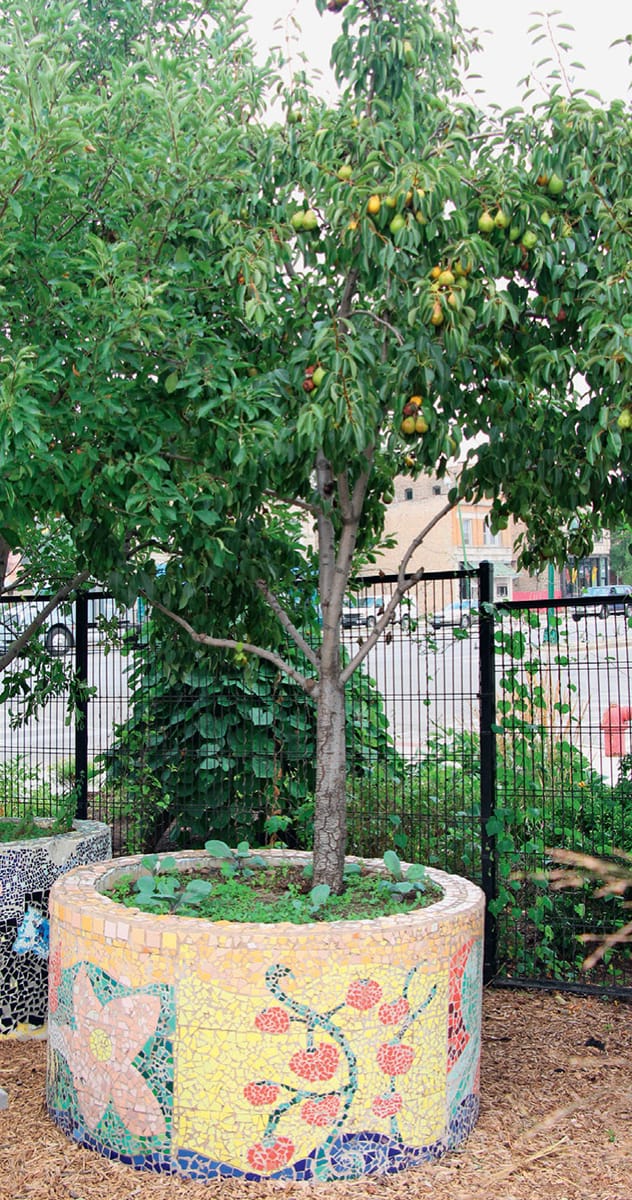
Dwarf fruit trees, such as this container-grown pear tree, are created through the process of grafting.
Keep in mind, though, that grafting is useful only for the generation of plants on which it was performed. The improvements or dwarfing traits made through grafting are not carried to the next generation via saved seeds or even by taking cuttings of the plant. It’s just for a single generation.
THE BIG FAKE-OUT
There is another method that greenhouses and commercial growers sometimes use to keep plants more compact and tidy, but it’s one that’s both temporary and, some say, questionable. Plant-growth regulators (PGRs) are chemical sprays that influence various plant hormones and cause an artificial and temporary mutation in the plant they’re applied to. Several different PGRs are used for a number of different reasons, but the ones I want to focus on here are applied to plants to inhibit their growth and keep the plants’ stems shorter.
Proponents say that using PGRs makes plants more attractive to the consumer (read: more neat and tidy) and easier to handle in the greenhouse (it’s tough to transport or sell a flat full of tall, leggy plants all tangled together). Those against using PGRs for height control in plant production note that few studies have been done to examine the safety of these chemicals, especially when used on edible plants like vegetables and herbs, or on the amount of residual PGRs remaining in these plants at the time of consumption.
Whether you’re pro or con when it comes to PGRs, it’s important to understand that once these plants are moved out into the landscape and applications are stopped, the plant will eventually revert to its normal size and growth habit. Don’t be fooled by PGRs. Do your homework and make sure the plant you’re purchasing hasn’t been forced into dwarfism via these products, only to grow back into a full-sized plant when placed in your garden.
THE COMPANIES THAT SELECT, GROW, AND SELL COMPACT PLANTS
Several decades ago, when I first entered the nursery trade, you had to go to your local family-run nursery to purchase plants. The nursery staff who worked there probably started most of their annual, perennial, and vegetable plants from seeds, divisions, or cuttings. They may have had field rows full of trees and shrubs out back, behind the greenhouse, from which they propagated and dug their nursery stock each spring. Yes, some garden centers purchased trees, shrubs, houseplants, and poinsettia cuttings from other nurseries; but they almost always played a huge hand in growing the plants they sold.
Now, things are a bit different in the nursery industry. Many (but not all) independent greenhouses and garden centers don’t actually grow much of their plant stock from scratch. Instead, they purchase immature plants from a larger commercial grower or a company that specializes in propagation, and then they pot those small plants into bigger containers in-house and grow them out to a salable size. Or, they buy and then resell already-mature plant material to their customers, having it shipped in from a diversity of wholesalers. Very few independent nurseries grow 100 percent of the nursery stock they sell at their operations anymore. In many ways, it’s a system that’s far more economical for these small businesses and a lot less labor intensive.

Very few nursery managers still grow all of their own stock from seed or cuttings. Most now purchase their plant stock from larger outside growers and propagators.
There are plenty of pros and cons to both the old and new way the nursery industry operates, however. Unfortunately, many smaller independent nurseries have closed down in recent years due to a variety of factors. The increased availability of cheaply priced plants at big-box retailers who purchase their plants in massive quantities from a network of contract growers is certainly one of those factors. But, as most gardeners come to realize, cheap doesn’t necessarily equal better. Independent nurseries care for their plants properly from start to sale, which, from my experience, can’t always be said about the staff at big-box stores.
Another perceived negative of this modern system is that some independent garden centers are limited in the variety of plants they have for sale. Plants can now be patented, preventing nursery owners from taking cuttings of these patented varieties and starting more plants on their own. And, if they’re buying their starter stock from another grower, nursery owners are limited to whatever varieties are grown there.
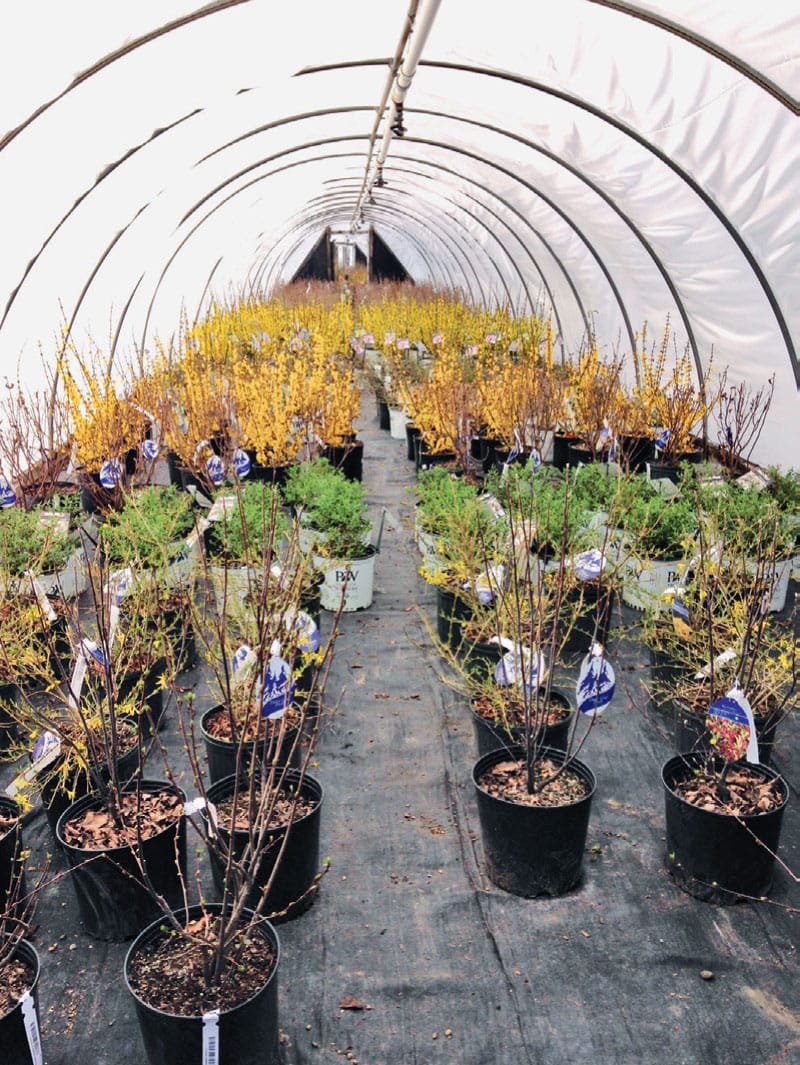
An improved distribution network allows many nurseries to get new plants in stock fairly quickly, though they tend to carry fewer varieties than in decades past.
A positive of this new nursery industry, however, is definitely increased plant availability, especially of a broad diversity of nationally branded plants. Years ago, it was often very difficult to find a specific plant, particularly if it was something a bit more unusual. You were limited to whatever your local nursery happened to grow that year. Now, even if a garden center doesn’t have a specific plant in stock, most can go to their broker network and get that plant for you in a fairly short amount of time. The distribution network and availability of plant material is, in many ways, much improved. If you read about a cool plant in a newspaper article (or this book!), chances are that you can readily get that plant either from one or more nurseries fairly close to home or from any number of mail-order nurseries who will ship it right to your door.
This modern nursery system is probably more pro than con to those seeking out compact plants. Plant breeders and growers develop, select, grow, and sell small-statured varieties to garden centers and direct to consumers more than ever before. Compact plants are among the most desired goals of the industry because there is a rapidly expanding need for them in the marketplace. It appears that the small-plant trend is here to stay. People want no-fuss plants that don’t require pruning and fit nicely into their smaller, modern yards and gardens.
As mentioned in the book’s introduction, at the back of this book you’ll find a source list. In it you’ll find many companies who breed, grow, and market the compact plant varieties found within these pages. If you find a plant in this book that you want to grow (I hope there are many), you’ll find that plant via one or more of the companies in the source list.
WHAT TO LOOK FOR WHEN SHOPPING FOR COMPACT PLANTS
Beyond the specific varieties of compact plants introduced later in this book, there are many others to be discovered. But how do you know a plant is going to be compact when you spy its colorful blooms or beautiful foliage on a trip to the garden center? Thankfully, there are many different clues to look for to help determine whether or not a plant has a more compact form.
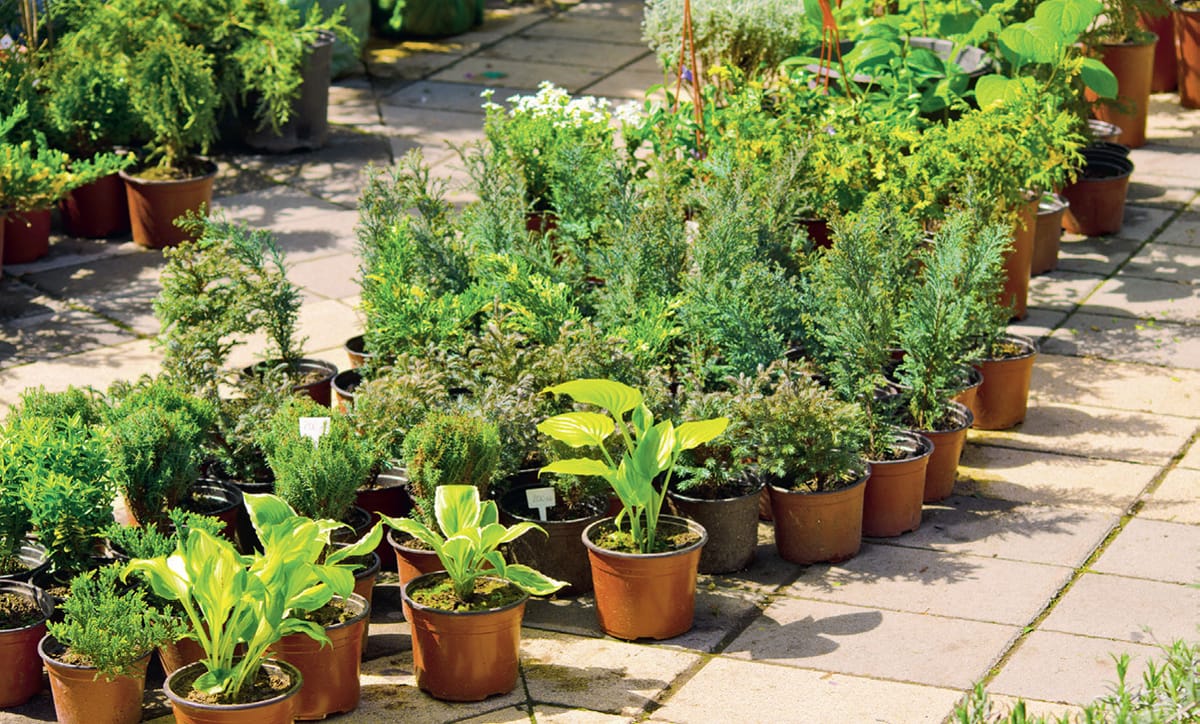
IF YOU’RE SHOPPING AT A NURSERY, THESE FOUR ARE A GOOD START:
1. THE TEXT ON THE PLANT’S POT TAG. There’s language to be on the lookout for when reading a plant’s pot tag. Phrases like “compact form,” “bush-type,” “container-friendly,” “small-statured,” “low-growing,” and the like will be on the tags of varieties that are compact or dwarf in form. Read the nursery’s signage and any materials displayed with the plants themselves for clues on the plant’s growth habit. The mature height and width of the plant are almost always clearly noted on the pot tag.
2. THE BOTANICAL NAME OF THE PLANT. Botanical names themselves have much to offer in terms of what they can tell you about a plant. Botanical names are binomial. The first word is the name of the genus of that plant, and the second is the specific epithet (commonly called the species). Sometimes, there’s an additional name after those two, in a set of single quotation marks. This is the cultivar (or variety) name of that species of plant. The cultivar name itself may indicate a compact growth habit (e.g., ‘Walker’s Low’ catmint, ‘Tiny Tim’ tomato, and ‘Dwarf Pagoda’ Japanese holly), but the Latin botanical name sheds even more light on specific plant traits. Keep a sharp eye out for species names that indicate some form of compact growth habit, including nana, compacta, alpinus, prostrata, procumbens, minima, minor, columnar, and fastigiate, to name just a few.
3. ASK SOMEONE. It may seem like a no-brainer to ask for help when you need it, but sometimes we all need to be reminded that there’s no shame in asking for help. If you do your plant shopping at an independent, local garden center, there should always be someone there who’s willing to answer any and all questions you have about the growth habits of any plant. And if they don’t know the answer off the top of their head, hopefully they can refer you to another employee or a reference book they keep close at hand.
4. USE YOUR CELL PHONE. If you have questions no one can answer, don’t be afraid to use Google. But, as I’m sure you already know, you can’t believe everything you read on the internet. Rely only on the information available from university extension service websites or those written by industry professionals, nursery operators, professional growers, horticulturists, professors, and others who work the trade. Do not rely on information posted by well-meaning bystanders in the comment section of somebody’s Facebook post. If you want accurate, university-distributed information about plants, simply add “site:edu” to the end of whatever phrase or word you’re Googling. For example, if you’re looking for a few good urban street trees, type “urban street trees site:edu” into the search bar. The first hits will be links to the topic only on university websites. It’s a lifesaver for anyone who wants to avoid bad information on the internet.

IF YOU’RE SHOPPING FROM A SEED CATALOG OR ONLINE SOURCE FOR COMPACT VEGETABLES, THERE ARE TWO ADDITIONAL THINGS TO WATCH FOR:
1. LOOK FOR KEYWORDS. When seeking out compact vegetable varieties in a catalog, look for words and phrases like “bush-type,” “compact,” “container-friendly,” and “small-statured.” They all translate to a smaller-than-normal growth habit for that particular vegetable.
2. CHECK THE DISEASE-RESISTANCE KEY CODE. While it has nothing to do with whether or not a plant is compact, most seed companies have a disease resistance key somewhere in their catalog or on their website that’s well worth paying attention to. In the description of each different vegetable variety, and often on the seed packet itself, there are code letters that note which pathogens that particular variety is resistant to (i.e., PM = powdery mildew, BW = bacterial wilt or TMV = tobacco mosaic virus). When shopping for compact vegetable varieties, you should also pay attention to this code and try to select cultivars with a natural resistance to common diseases. It saves you a lot of trouble later in the season.

Dwarf tomatoes, like this one, are a great fit for containers. When seeking compact varieties, look for terms such as “compact form,” “bush type,” or “container-friendly” for clues about the plant’s mature height.
A WORD ON COMPACT PLANTS AND POLLINATORS
Before wrapping up this chapter and moving on to tips for planting and maintaining compact plants, it’s worth taking a brief look into a topic that’s of great concern to many gardeners: the health of our pollinators.
As you may already know, European honeybees aren’t the only important pollinators to make a home in our yards and gardens. In fact, North America is home to some 4,000 species of native bees—from fat and sassy bumblebees to tiny, iridescent sweat bees—many of which are facing population declines due to habitat loss, lack of forage, and pesticide exposure.
There’s been much talk in the gardening world about how plant breeding and the introduction of various cultivars of plants impact the health of pollinators. On the tip of many a tongue, my own included, are questions like
• When a plant is bred to have bigger blooms, how does that impact the accessibility of its nectar?
• Can pollinators access pollen and nectar from the thick layers of petals when we breed a plant to produce double flowers?
• When we change the color of a flower through breeding, does that impact a pollinator’s ability to find that plant?
• Does breeding for a shorter or taller plant stature impact nectar accessibility to certain low- or high-flying insects?
• When we breed a plant to appeal only to a human’s sense of beauty, how does that impact the quality and quantity of the nectar it produces?
As the author of Attracting Beneficial Bugs to Your Garden, I have a keen interest in understanding the role our plant choices have in supporting our native insects. It’s led me to carefully consider each plant I think about adding to my own garden before bringing it home and planting it.

Many compact plants, such as this Sapphire Surf™ bluebeard (Caryopteris x clandonensis ‘Blauer Splatz’), attract and support pollinators, though it’s important to consider many factors when determining the pollinator appeal of a particular plant.
A few studies have been done, with more under way, that examine the pollinator appeal of plant cultivars and the effects of plant breeding on nectar quality and fitness. Some folks think the impact of this breeding on pollinating insects is minimal, as evidenced by the number and diversity of insects foraging on the plants’ nectar, while others sing the praises of using only regionally native plants that have not been bred into cultivar form. Both sides are passionate and vocal. Do I have the answer? No, certainly not. But I do know that in my own garden, I have a mixture of native plants in their straight species form, along with lots of cultivars of both native and non-native plants. My personal belief is that creating a pesticide-free habitat, full of a broad diversity of plants, flower structures and colors, and bloom times is key to supporting all types of insects, including pollinators.
As you’ll soon see, there are many compact plant varieties that are known to support a diversity of pollinators in the landscape, and including them in your garden doesn’t just add beauty; it also adds forage and habitat for these insects.
WHAT’S NEXT?
Now that you know a bit more about the traits that make a plant compact, how these plants are brought to market, and what to look for on your next shopping trip, it’s time to look at how best to plant and care for them.
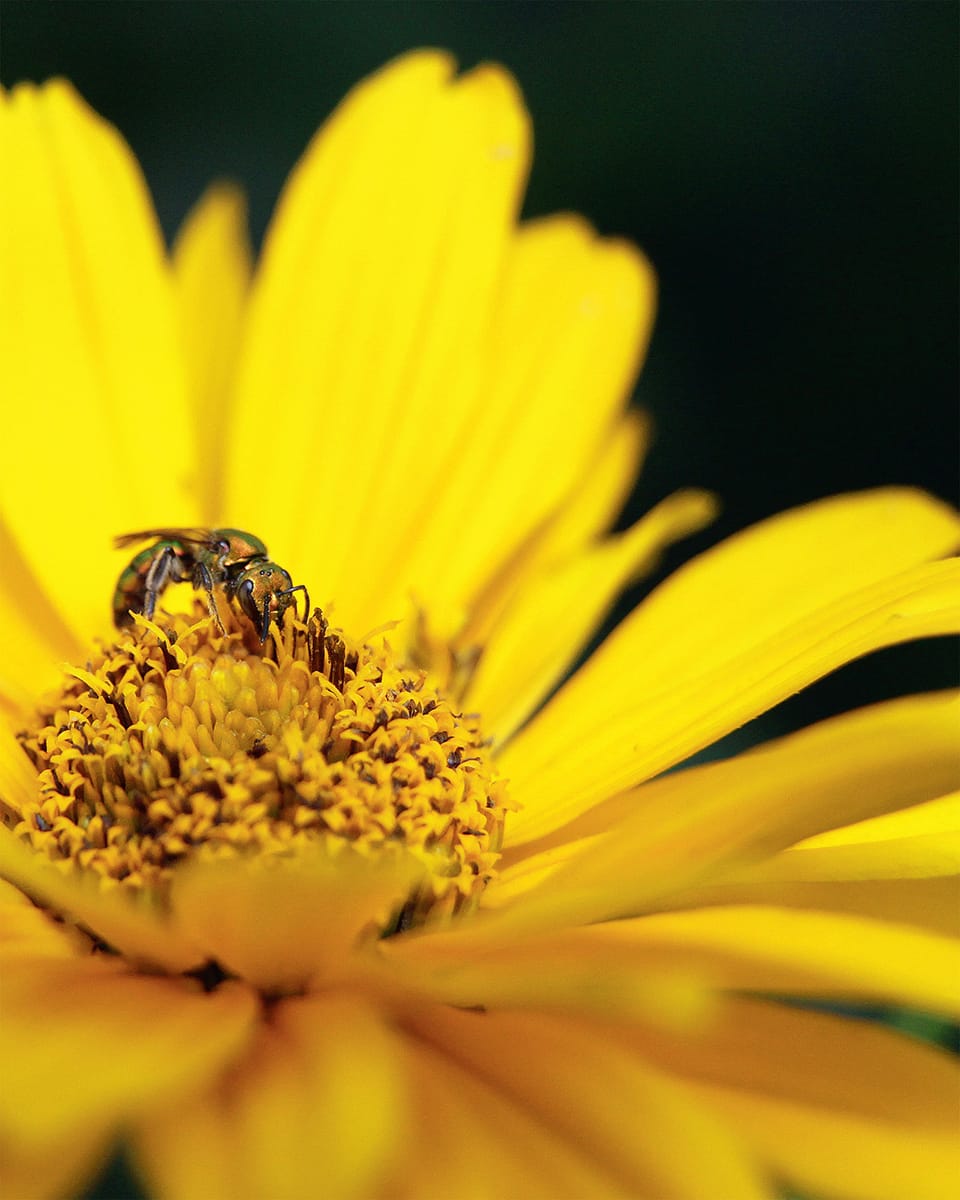
There are over 4000 species of native bees, including this tiny sweat bee, that use our yards and gardens as a source of nutrition and habitat.